
Salix purpurea, the purple willow, purpleosier willow, or purple osier, is a species of willow native to most of Europe and western Asia north to the British Isles, Poland, and the Baltic States.

Salix viminalis, the basket willow, common osier or osier, is a species of willow native to Europe, Western Asia, and the Himalayas.

Salix amygdaloides, the almond leaf willow or peach leaf willow, is a species of willow native to central North America east of the Cascade Range. It can be found in southern Canada and the United States—from western British Columbia to Quebec, Idaho, Montana and Arizona to eastern Kentucky. As of 2022, it is presumed extirpated from the state of Kentucky.
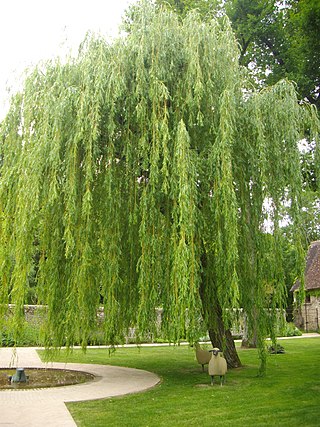
Salix babylonica is a species of willow native to dry areas of northern China, but cultivated for millennia elsewhere in Asia, being traded along the Silk Road to southwest Asia and Europe.

Salix pentandra, the bay willow, is a species of willow native to northern Europe and northern Asia. The scientific name refers to the male flowers having five stamens. The English name derives from the resemblance of the leaves to those of the bay laurel; other common names include bay-leaved willow and laurel willow. Its glossy leaves make it more decorative than many other willows, so it is often planted as an ornamental tree.

Salix cinerea is a species of willow native to Europe and western Asia.

Salix nigra, the black willow, is a species of willow native to eastern North America, from New Brunswick and southern Ontario west to Minnesota, and south to northern Florida and Texas.

Salix lasiolepis is a species of willow native to western North America.

Salix lucida, the shining willow, Pacific willow, red willow, or whiplash willow, is a species of willow native to northern and western North America, occurring in wetland habitats. It is the largest willow found in British Columbia.

Salix atrocinerea, commonly called grey willow or large gray willow, is a species of willow. It is a bush or small tree up to 12 m (39 ft) tall. As a pioneer species of willow, it quickly colonizes poor soils.

Salix bebbiana is a species of willow indigenous to Canada and the northern United States, from Alaska and Yukon south to California and Arizona and northeast to Newfoundland and New England. Common names include beaked willow, long-beaked willow, gray willow, and Bebb's willow. This species is also called red willow by Native Americans according to The Arctic Prairies Appendix E by Ernest Tompson Seton.

Salix laevigata, the red willow or polished willow, is a species of willow native to the southwestern United States and northern Baja California.
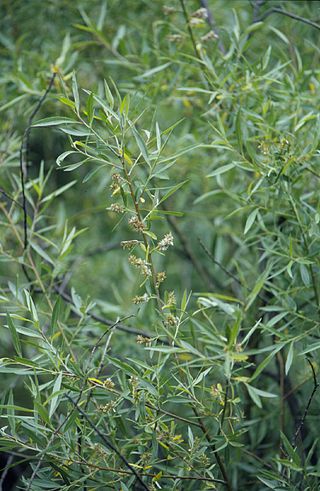
Salix geyeriana is a species of willow known by the common names Geyer's willow, Geyer willow and silver willow. The type specimen was collected by the botanist Karl Andreas Geyer, for whom it was named. Its conspicuous, yellow flowers begin to bloom as early as March, to as late as the end of June.

Salix lutea is a species of willow known by the common name yellow willow. It is native to North America, including central Canada and parts of the western and central United States, with the exception of the Great Basin. It can be found in moist and wet habitat types, such as riverbanks, meadows, and gullies. It is a shrub up to 7 m tall, sometimes forming colonial thickets or becoming erect and treelike. The lance-shaped leaves may grow over 11 cm long and may have smooth, lightly serrated, wavy, or gland-studded edges. The inflorescence is a catkin of flowers up to 4 or 5 cm long, stout to slender in shape.

Salix melanopsis is a plant species known by the common name dusky willow. It is native to western North America from British Columbia and Alberta to California and Colorado, where it grows in many types of moist and wet habitat, such as riverbanks and subalpine mountain meadows, on rocky and silty substrates.
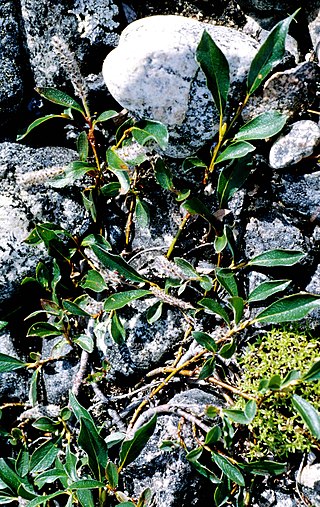
Salix planifolia is a species of willow known by the common names planeleaf willow, diamondleaf willow, and tea-leafed willow. It is native to northern and western North America, including most of Canada and the western United States. It grows in many types of arctic and alpine habitats in the north, and mountainous areas in the southern part of its range.

Salix glauca is a species of flowering plant in the willow family known by the common names gray willow, grayleaf willow, white willow, and glaucous willow. It is native to North America, where it occurs throughout much of Alaska, northern and western Canada, and the contiguous United States south through the Rocky Mountains to northern New Mexico. It can also be found in Greenland, northwestern Europe, and Siberia.
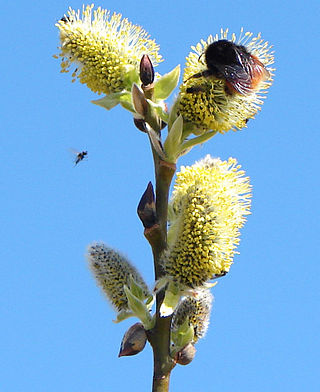
Salix monticola is a species of flowering plant in the willow family known by the common names mountain willow, cherry willow, serviceberry willow, and park willow. It is native to the United States, where it occurs in the Rocky Mountains region from Wyoming to Arizona and New Mexico. It also occurs in Alaska and parts of Canada.
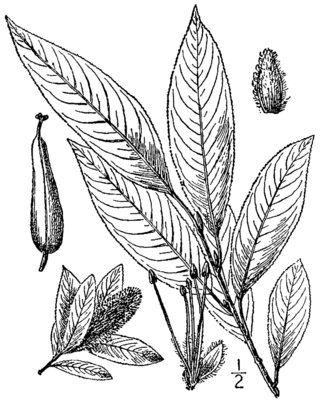
Salix serissima is a species of flowering plant in the willow family known by the common names autumn willow and fall willow. It is native to North America, where it is distributed across much of Canada and the northern contiguous United States.
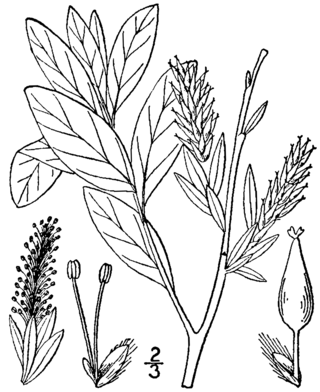
Salix pedicellaris, the bog willow, is a species of willow. It grows as a shrub.






















